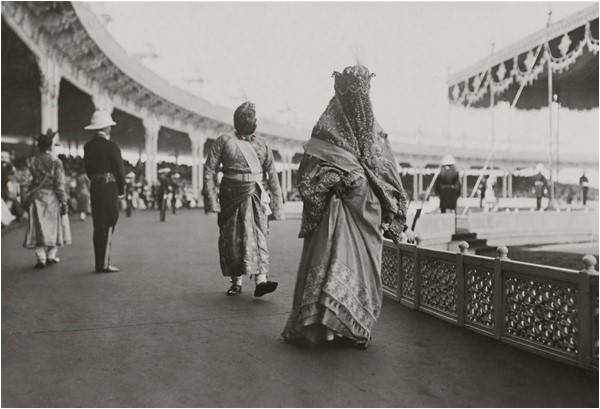
In this photograph, by Bourne and Shepherd, Begum of Bhopal Sultan Kaikhusrau Jahan (1858-1930) walks in full niqab at the Delhi Durbar. She ruled the Indian state of Bhopal, now part of Madhya Pradesh, from 1901 to 1926. She was the only surviving child of Nawab Sultan Shah Jahan Begum Sahiba by her first husband, General Nasir ud-Daula, Nawab Baqi Muhammad Khan Bahadur.
Among her achievements as a progressive and reforming leader, are the founding of educational institutions and the introduction of free compulsory primary education, in 1918. She overhauled taxation, the army, the police, the judiciary and prisons, expanded agriculture, and improved public sanitation and health by means of widespread inoculation and vaccination programmes.
She attended the Coronation of George V and Queen Mary at Westminster Abbey in 1911, and among her many awards and titles, Knight Grand Commander of the Order of the Star of India was conferred in 1910.
Between 1819 and 1926 four Muslim women rulers reigned over Bhopal, the second largest Muslim state of India, despite staunch opposition from powerful neighbors and male claimants. Even the British India Company initially opposed female rule in Bhopal until the Begums quoted Queen Victoria as their model and inspiration. Each Begum–or Queen–impressed her own personality on the role and succeeded in reigning over a mostly Hindu population. Qudisa was the first Begum. She was succeeded in 1844 by Sikandar, her only daughter, who was also followed by her only daughter, the highly controversial Shahjehan. The story ends with the last Begum, Sultan Jehan, and her abdication in favor of her son, the first male ruler (Nawab) of Bhopal in five generations (“The Begum of Bhopal”).
Begum Shahjehan, a highly educated woman, financed one of the most respected Urdu biographies of the Prophet Muhammad (PBUH) written by Sulaiman Nadwi. She also wore a full niqab while attending the coronation of King George V in 1911. Shahjehan Begum was known for commencing the construction of the Taj-ul-Masjid mosque in Bhopal and for other public work projects such as subsidising the cost of a railway to be constructed between Hoshangabad and Bhopal. (“Old Indian Photos”)
The Alkazi collection of photography is considered India’s largest archive of 19th and early 20th century photographs. It amounts to over 90,000 images held in Delhi, London and New York. It is located in New Delhi. Sources: British photographic history.com & acparchives.com.
Among her achievements as a progressive and reforming leader, are the founding of educational institutions and the introduction of free compulsory primary education, in 1918. She overhauled taxation, the army, the police, the judiciary and prisons, expanded agriculture, and improved public sanitation and health by means of widespread inoculation and vaccination programmes.
She attended the Coronation of George V and Queen Mary at Westminster Abbey in 1911, and among her many awards and titles, Knight Grand Commander of the Order of the Star of India was conferred in 1910.
Between 1819 and 1926 four Muslim women rulers reigned over Bhopal, the second largest Muslim state of India, despite staunch opposition from powerful neighbors and male claimants. Even the British India Company initially opposed female rule in Bhopal until the Begums quoted Queen Victoria as their model and inspiration. Each Begum–or Queen–impressed her own personality on the role and succeeded in reigning over a mostly Hindu population. Qudisa was the first Begum. She was succeeded in 1844 by Sikandar, her only daughter, who was also followed by her only daughter, the highly controversial Shahjehan. The story ends with the last Begum, Sultan Jehan, and her abdication in favor of her son, the first male ruler (Nawab) of Bhopal in five generations (“The Begum of Bhopal”).
Begum Shahjehan, a highly educated woman, financed one of the most respected Urdu biographies of the Prophet Muhammad (PBUH) written by Sulaiman Nadwi. She also wore a full niqab while attending the coronation of King George V in 1911. Shahjehan Begum was known for commencing the construction of the Taj-ul-Masjid mosque in Bhopal and for other public work projects such as subsidising the cost of a railway to be constructed between Hoshangabad and Bhopal. (“Old Indian Photos”)
The Alkazi collection of photography is considered India’s largest archive of 19th and early 20th century photographs. It amounts to over 90,000 images held in Delhi, London and New York. It is located in New Delhi. Sources: British photographic history.com & acparchives.com.

